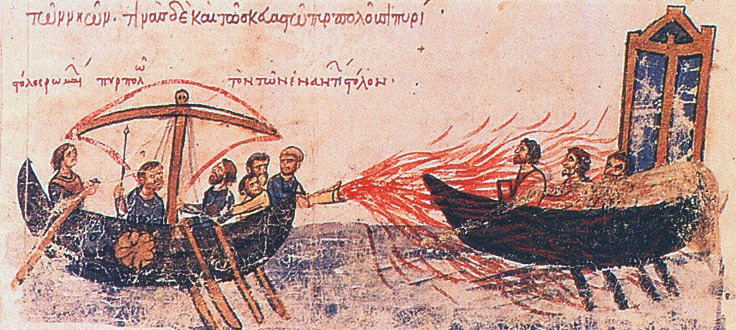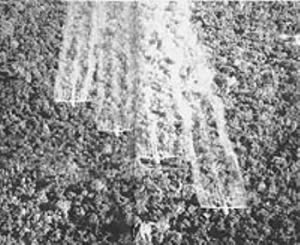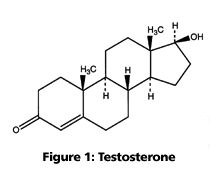Entries from April 2008
Historical Overview | Discovery & Development | Chemical Composition | Use in Warfare | Home
Napalm is a strong and thick gel (jelly). In its original configuration, it consisted of combination of two aluminum soaps with gasoline: aluminum naphtanate and aluminum palmitate. Their structure contains rings and chains of carbon atoms.
[Read more →]
Categories: Napalm
Historical Overview | Discovery & Development | Chemical Composition | Use in Warfare | Home
Chemical warfare has been around for a number of centuries, starting with what we now call “Greek Fire”. Allegedly, Greek Fire was liquid fire which was impossible or very difficult to extinguish and was extremely devastating.
Historical records indicate a very important victory involving Greek Fire in 678 AD. The Byzantine Empire was able to overwhelm the Arabs at Constantinople using the secret liquid weapon. This was an emblematic “turning point in the history of mankind” since scientists speculate that had it not been for Greek Fire, Europe could have looked differently today.
Even though the exact composition is unknown, Greek fire appears to have been very close to what we now call Napalm.

From the Skylitzes manuscript in Madrid
[Read more →]
Categories: Napalm
Introductionto Estradiol, Definition and Structure, Estradiol’s Effect on History: Medicinal Purposes, Estradiol’s Effect on History: Therapeutic Purposes, History’s Effect on Estradiol
Definition:
- Estradiol is a sex hormone present in both females and males.
- Estradiol is one of the three naturally occuring estrogens in females, along with estriol and estrone
- It is present in women from puberty until menopause
- It is essential for the reproductive system, as well as for sexual reasons
- Affects many of the body’s major systems
- Synthetic estradiol is used in the pill, for hormone replacement therapy in transsexuals, and for postmenopausal women
- Estradiol is derived from cholesterol which is converted into androstenedione. Androstendione is then converted to testosterone which in turn is converted to estradiol
Structure
- C18H24O2
- Molecular mass is 272.39
- White, crystalline solid
- Structure:

- Conversion from Testosterone to Estradiol:

[Read more →]
Categories: Estradiol
Historical Overview | Discovery & Development | Chemical Composition | Use in Warfare | Home
Napalm is the name of a group of substances used to thicken gasoline for war-effective purposes. Its relationship with history has been very close throughout its development and use starting with World War II and escalating through the Vietnam War.
Napalm has been a very controversial weapon for its excruciating physical and psychological effects. It has been publicized in popular culture in movies such as Apocalypse Now. During the Vietnam War, many protests were associated with the use of Napalm.

A Napalm attack in Vietnam
[Read more →]
Categories: Napalm
Categories: Testosterone
History of Perfumes/ Perfume Ingredients/ The Family of Esters/ Formula of Benzyl Acetate/ Properties of Benzyl Acetate/ Uses of Benzyl Acetate/ Benzyl Acetate in Perfumes

They are products of the “esterification” reaction occurring between alcohols and acids. Water is separated as a second product. The reverse reaction is called “hydrolysis.”

Esters have small molecular weight and very nice odor. They are responsible for the pleasant odor of jasmine, roses, etc. and for the odors of apples, bananas, strawberries, etc. The higher the molecular weight, the weaker the odors they carry are.
Unsaturated esters have stronger odor than the saturated ones.
Esters are used in the fragrance and flavoring industries. They also have implication as fixatives and carrier solvents.
1800s -1st fragrances which imitated naturally occurring esters were synthesized in a laboratory.
[Read more →]
Categories: Perfume (Esters)
April 24th, 2008 · 1 Comment
Intro to Agent Orange | History of Herbicides and Early Beginnings of Agent Orange | Use of Agent Orange in Vietnam | Effect of its use in Vietnam
The Effects of Agent Oranges use in Vietnam
Actually herbicide 2,4-D not toxic at all
Either is technically 2,4,5-T. However, in it’s industrial creation it is inevitably contaminated by highly toxic dioxins and because of this 2,4,5-T has been banned in the United States and around the world.
The U.S. Cancer society on their web page have surveyed most of the major studies done on U.S. army veterans of Vietnam and the connections between Agent Orange and cancer
The U.S. cancer society cited that many of the tests and studies done have been varied and inconclusive because of the small amount of people actually heavily exposed to Agent Orange.
To add to the inconclusiveness of many studies is the fact that results have taken sometime to formulate because it has taken Vietnam veterans to increase in age for more details and facts to come out about the association between Argent Orange and different cancers.
[Read more →]
Categories: Agent Orange
April 24th, 2008 · Comments Off on Use of Agent Orange in Vietnam
Intro to Agent Orange | History of Herbicides and Early Beginnings of Agent Orange | Use of Agent Orange in Vietnam | Effect of its use in Vietnam

After favorable initial testing in both the U.S. and Puerto Rico, Agent Orange was shipped to Vietnam in 1960 to begin field-testing on the request of South Vietnamese high command.
What proceeded was a full-blown operation that lasted from 1962 -1971, where almost 40 million pounds of Agent Orange was sprayed over an area of 5 Million Acres. The Operation was called Ranch Hand and was carried out by crack pilots from the 309th Air Commando Squadron flying special outfitted C-123’s.
The main target areas of Operation Ranch Hand where as such
o Along the banks of the rivers and canals of South Vietnam because they were major traffic routes and the jungle vegetation made them easily susceptible to ambushes.
o Rain and evergreen forests were sprayed heavily as well because it was in these deep jungle areas that the Viet Cong hid their movements, their fortifications and movement of men and supply.
o The dense shrubberies along highways were also sprayed heavily because of the concealments they created for VC ambushes. (Harvest of Death)
o Also crops that were thought to be supplying the VC mostly coming form the mountainous region of South Vietnam

From 1962 – 1967 The use of herbicides increased three hundredfold in the span of five years. This can be mainly attributed to the fact that U.S. Army field commanders gave the use of herbicides such rave reviews and were continually asking for it to be more heavily sprayed in their sectors.
By 1971 an area of 5 million acres had been sprayed
President Nixon finally ended the Operation Ranch Hand due to growing criticism from the scientific community and a pending report from the American Association for the Advancement of Science. The AAAS had sent an independent team to South Vietnam to survey the effect of the mass use of Agent Orange.
o The report, while citing the need for further research into the health effects, stated that Agent Orange had caused serious ecological damage on a large scale to the Vietnam countryside.
[Read more →]
Categories: Agent Orange
April 24th, 2008 · 1 Comment
Intro to Agent Orange | History of Herbicides and Early Beginnings of Agent Orange | Use of Agent Orange in Vietnam | Effect of its use in Vietnam
Growth regulating chemicals and other synthetic plant hormones were first experiment with and created in the late 1920’s and throughout the 1930’s
However, it was in 1942 that E.J Kraus, the head of the Botany Department of the University of Chicago discovered that in high concentration 2,4,-D contained the toxic properties necessary for crop destruction and limitation of crop growth.
He then pitched this idea to the National Academy of Sciences, which parlayed itself into a contract with the U.S. Army to test chemicals for their herbicidal properties.
Because of Kraus’s work, in 1944 the U.S. Army made herbicidal research a main component at the Biological Research and Testing Center at Camp Detrick.
In 1945 it was the conclusion of the Testing Center that ammonium thiocyanate could be used as a viable herbicide to deny the Japanese of jungle vegetation as cover. However, the war ended just as the first canisters of the chemical were on route to the pacific theater.
What’s interesting about 2,4-D and 2,4,5-T, the two chemicals that would end up being “Agent Orange”, is that while they were created during WWII for military use their most immediate application was after the war for civilian use.
o 2,4,-D became the most widely used herbicide in America with both farmers using it to clear weeds and home owners using it to maintain their lawns.
o 2,4,5-T was the preferred herbicide for us in clearing railroad tracks, power-line routes and cattle trails (2,4,5-T much more effective and destroying woody plants).

By 1960 3% of the country was being sprayed by herbicides
It has been suggested by one writer, Thomas Whiteside, that the commercial success of Herbicides was the reason that the press and general public did not take much notice of the massive herbicide operations in Vietnam in the 1960’s. At the time herbicides were a new wonder chemical that was helping many people across the country and U.S. citizens did not think then that it could be harmful or consider its use as a form of chemical warfare.
Another interesting side note about the creation of Agent Orange is on the subject of the prototypes molecule the U.S. Army used to create 2,4-D and 2,4,5-T. The Prototype was 2,3,5,-Triiodobenzoic acid and it was serendipitously discovered to be an effective defoliant By Dr. Arthur Galston in 1943 when he was a graduate student looking for ways to speed up the growth of soybeans. Even though he had nothing to do with the creation of Agent Orange, as a professor at Yale during the Vietnam War he expressly stated his feelings of responsibility and guilt for it being used as a weapon of war and was one of the most instrumental and influential scientists in the effort to finally have the President stop it’s use.
[Read more →]
Categories: Agent Orange
Intro to Agent Orange | History of Herbicides and Early Beginnings of Agent Orange | Use of Agent Orange in Vietnam | Effect of its use in Vietnam
Agent Orang is a 50-50 mixture of n-butyl esters of 2,4,- Dichlorophenoxyacetic acid and 2,4,5,- Tricholorophenoxyacetic acid. The U.S. Armies name, “Agent Orange”, orginiated from the simply fact that the chemical was shipped to Vietnam in bright orange barrels.
2,4 Dichlorophenoxyacetic Acid
2,4,5 trichlorophenoxyacetic
Agent Orange is usually dissolved in an organic solvent such as diesel oil or kerosene before being used as a spray. Agent Orange was most commonly implemented by being sprayed out of slow and low flying transport planes.
Agent Orange is a general-purpose herbicide meaning that it doesn’t differentiate between plant -life. Many Herbicides are created so that when they are applied they don’t harm crops, but kill weeds and other unwanted plant life. When Agent Orange is sprayed all plant-life defoliates in about three to six weeks and it persists doing that for about 7 to 12 months.
Agent Orange is also what is classified as a systemic herbicide, which is absorbed either by the roots or the foliar part of a plant and then is translocated within the plant system to tissues that may be remote from the point of application. Furthermore as a Phenoxy Acid Type herbicide, Agent Orange acts as a synthetic growth hormone, mimicking the natural auxins that occur within plants, which allow for the chemical to be readily absorbed by the foliage
It is important to note that while 61% of all Herbicides sprayed in the almost decade long operation consisted of Agent Orange, other Herbicides were used in Vietnam. For example Agent Purple, Agent White and Agent Blue
o Agent Purple being almost identical to Agent Orange, but simply having a slightly different molecular make-up
o Agent White being the most powerful and persistent jungle defoliator.
o Agent Blue is notable because it was used for destruction of crops, which though only accounted for 14% of the overall herbicide spray missions was nonetheless very controversial.
[Read more →]
Categories: Agent Orange









